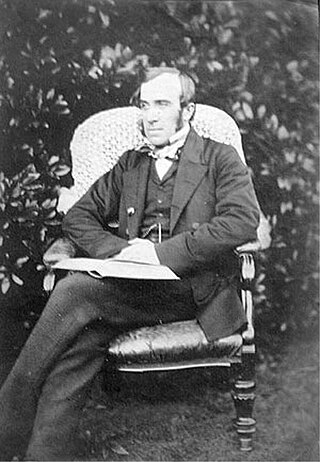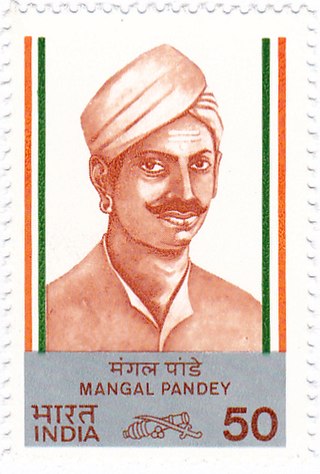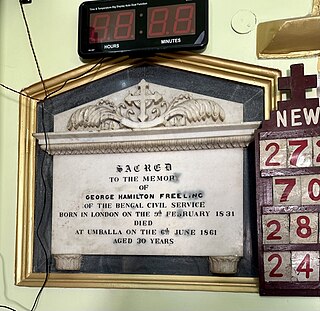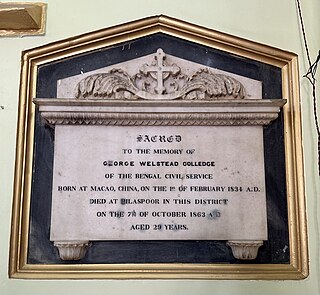Related Research Articles

The East India Company College, or East India College, was an educational establishment situated at Hailey, Hertfordshire, nineteen miles north of London, founded in 1806 to train "writers" (administrators) for the East India Company. It provided general and vocational education for young gentlemen of sixteen to eighteen years old, who were nominated by the Company's directors to writerships in its overseas civil service. The college's counterpart for the training of officers for the company's Presidency armies was Addiscombe Military Seminary, Surrey.

Sir John William Kaye was a British military historian, civil servant and army officer in India. His major works on military history include a three-volume work on The History of the Sepoy War in India. This work was revised later by George Bruce Malleson and published in six volumes in 1890 as Kaye and Malleson's History of the Indian Mutiny.

Sir Monier Monier-Williams was a British scholar who was the second Boden Professor of Sanskrit at Oxford University, England. He studied, documented and taught Asian languages, especially Sanskrit, Persian and Hindustani.

The Indian Rebellion of 1857 was a major uprising in India in 1857–58 against the rule of the British East India Company, which functioned as a sovereign power on behalf of the British Crown. The rebellion began on 10 May 1857 in the form of a mutiny of sepoys of the company's army in the garrison town of Meerut, 40 mi (64 km) northeast of Delhi. It then erupted into other mutinies and civilian rebellions chiefly in the upper Gangetic plain and central India, though incidents of revolt also occurred farther north and east. The rebellion posed a military threat to British power in that region, and was contained only with the rebels' defeat in Gwalior on 20 June 1858. On 1 November 1858, the British granted amnesty to all rebels not involved in murder, though they did not declare the hostilities to have formally ended until 8 July 1859.

John Laird Mair Lawrence, 1st Baron Lawrence,, known as Sir John Lawrence, Bt., between 1858 and 1869, was a prominent British Imperial statesman and served as the Viceroy of India from 1864 to 1869.

Mangal Pandey was an Indian soldier who played a key role in the events taking place just before the outbreak of the Indian rebellion of 1857. He was a sepoy (infantryman) in the 34th Bengal Native Infantry (BNI) regiment of the British East India Company. In 1984, the Indian government issued a postage stamp to remember him. His life and actions have also been portrayed in several cinematic productions.

The siege of Cawnpore was a key episode in the Indian rebellion of 1857. The besieged East India Company forces and civilians in Cawnpore were duped into a false assurance of a safe passage to Allahabad by the rebel forces under Nana Sahib. Their evacuation from Cawnpore thus turned into a massacre, and most of the men were killed and women and children taken to a nearby dwelling known as Bibighur. As an East India Company rescue force from Allahabad approached Cawnpore, 120 British women and children captured by the rebels were butchered in what came to be known as the Bibighar Massacre, their remains then thrown down a nearby well. Following the recapture of Cawnpore and the discovery of the massacre, the angry Company forces engaged in widespread retaliation against captured rebel soldiers and local civilians. The murders greatly enraged the British rank-and-file against the Sepoy rebels and inspired the war cry "Remember Cawnpore!".

Azimullah Khan Yusufzai , also known as Dewan Azimullah Khan, was initially appointed Secretary, and later Prime Minister to Maratha Peshwa Nana Saheb II.

General Bakht Khan (1797–1859) was the commander-in-chief of the Indian rebel forces in the city of Delhi during the Indian Rebellion of 1857 against the East India Company.
Civil Lines is a Civil Lines neighborhood of Prayagraj, Uttar Pradesh, India. It is the upper-class central business district of the city and is famous for its urban setting, gridiron plan roads high rise buildings, offices, cafes, restaurants, hotels, malls, shopping complexes, theatres etc. Built in 1857, under the supervision of Cuthbert Bensley Thornhill, it was the largest town-planning project carried out in India before the establishment of New Delhi.
The Indian Rebellion of 1857 has been variously termed as a war of independence, a rebellion, and a mutiny. Several Indian writers, who consider it as a part of the Indian independence movement that ultimately led to the country's independence in 1947, have termed it as "The First War of Independence", the "great revolution", the "great rebellion", and the "Indian freedom struggle". Several British writers, who view it as a military disturbance, have termed it as "sepoy revolt", "sepoy war", "Indian rebellion", and the "great revolt". Since the 19th century, a section of British writers have challenged the choice of the word "mutiny" to describe the events.

Dhan Singh Gurjar, also known as Dhunna Singh, was the Indian Kotwal of Meerut, who participated in the 1857 rebellion and led initial actions against the British East India Company in that city.

Blowing from a gun is a method of execution in which the victim is typically tied to the mouth of a cannon which is then fired, resulting in death. George Carter Stent described the process as follows:
The prisoner is generally tied to a gun with the upper part of the small of his back resting against the muzzle. When the gun is fired, his head is seen to go straight up into the air some forty or fifty feet; the arms fly off right and left, high up in the air, and fall at, perhaps, a hundred yards distance; the legs drop to the ground beneath the muzzle of the gun; and the body is literally blown away altogether, not a vestige being seen.

The Vellore mutiny, or Vellore Revolution, occurred on 10 July 1806 and was the first instance of a large-scale and violent mutiny by Indian sepoys against the East India Company, predating the Indian Rebellion of 1857 by half a century. The revolt, which took place in the Indian city of Vellore, lasted one full day, during which mutineers seized the Vellore Fort and killed or wounded 200 British troops. The mutiny was subdued by cavalry and artillery from Arcot. Total deaths amongst the mutineers were approximately 350; with summary executions of about 100 during the suppression of the outbreak, followed by the formal court-martial of smaller numbers.
Chetram Jatav was an Indian revolutionary who participated in Indian Rebellion of 1857.
The chapati movement involved the unusual distribution of chapatis, a type of unleavened flatbread, across several North Indian villages in early 1857. The ultimate origin of the movement is unknown; though British agents suggested the chapatis might contain secret notes, inspections revealed no such messages.
General Morden Carthew CB was an officer in the service of the East India Company (E.I.C.) Indian Army in the Madras Presidency, India and South East Asia during the mid 19th century.
The Indian Rebellion of 1857 was a significant uprising against British colonial rule in India from 1857 to 1858. It was directed against the authority of the British East India Company, which acted as a self-governing entity on behalf of the British Crown. Indian Muslim soldiers, known as sepoys, were instrumental in igniting the rebellion, driven by rumors that the cartridges for their rifles were greased with animal fat, which offended their religious beliefs. In regions such as Awadh, Delhi, Bihar, and Bengal, Muslim leaders emerged as key figures in the uprising. Prominent figures like Bahadur Shah II, the last Mughal emperor, and Maulvi Ahmadullah Shah led significant uprisings against the British, symbolizing a desire for the restoration of Muslim political power.

George Hamilton Freeling was a British civil servant of the Indian Civil Service (ICS) and collector at Bulandshahr, India. He was succeeded by William Lowe.

George Welstead Colledge was a British joint magistrate and deputy collector at Bulandshahr, India, where he died at the age of 29. He was born in Macau, the eldest son of Thomas Richardson Colledge, gained admission to Haileybury (1851-1853), and passed the examination of the Indian Civil Service at a young age. During the Indian Rebellion of 1857 he served at Saharanpur, Uttar Pradesh.
References
- ↑ London, England, Church of England Births and Baptisms. Great Stanmore: St John the Evangelist. 1813–1923. p. 47.
- ↑ The Personal Adventures and Experiences of a Magistrate During the Rise, Progress, and Suppression of the Indian Mutiny. Cambridge University Press. 2012. p. 1. ISBN 978-1-108-04470-7.
- 1 2 The Asiatic Journal and Monthly Register for British and Foreign India, China, and Australia. Parbury, Allen, and Company. 1840. p. 287.
- ↑ Danvers, Frederick Charles; Monier-Williams, Sir Monier; Bayley, Sir Steuart Colvin; Wigram, Percy; Sapte, Brand (1894). "Active services of old Haileyburians during the mutiny". Memorials of Old Haileybury College. A. Constable. p. 623.
- 1 2 East-India Register and Army List. Calcutta: Ramchunder Doss. 1856. p. 382.
- ↑ Dewar, Douglas (1922). Bygone Days in India. John Lane. p. 191.
- ↑ Edmond, E. (1845). The Bengal Civil Service Gradation List, 1845-46. Calcutta: Thacker. p. 49.
- ↑ "North Western Provinces appointments" . Friend of India and Statesman. 27 July 1854. p. 474 – via British Newspaper Archive.
- ↑ The Army and Navy Magazine. W.H. Allen. 1883. p. 35.
- ↑ Dalrymple, William (17 August 2009). The Last Mughal: The Fall of Delhi, 1857. A&C Black. ISBN 978-1-4088-0688-3.
- ↑ Padamsee, A. (2 August 2005). Representations of Indian Muslims in British Colonial Discourse. Springer. p. 106. ISBN 978-0-230-51247-4.
- 1 2 Anderson, Clare (September 2007). The Indian Uprising Of 1857-8: Prisons, Prisoners and Rebellion. Anthem Press. pp. 64–65. ISBN 978-1-84331-387-8.
- ↑ Nayar, Pramod K. (2017). "Key words". The British Raj: Keywords. Routledge. pp. 43–44. ISBN 978-1-351-97242-0.
- ↑ Ahmad, Aijaz (2021). "10. General uprising or popular perspective". Uprising of 1857: Some Facts about Failure of Indian war of Independence. New Delhi: K.K. Publications. p. 182.
- ↑ Kaye, Sir John William (1897). "4. The Agra and Rohilkhand Divisions". Kaye's and Malleson's History of the Indian Mutiny of 1857-8. Vol. VI. New York: Longmans, Green, and Company. pp. 85–90.
- ↑ Dash, Mike. "Pass it on: The Secret that Preceded the Indian Rebellion of 1857". Smithsonian Magazine. Retrieved 6 May 2023.
- ↑ Library, Boston Public (1900). Monthly Bulletin of Books Added to the Public Library of the City of Boston. The Trustees. p. 200.
- ↑ Bancroft, James W. (2020). The Devil's Trap: The Victims of the Cawnpore Massacre During the Indian Mutiny. Pen and Sword. p. 146. ISBN 978-1-5267-1803-7.
- ↑ Fuerst, Ilyse R. Morgenstein (23 January 2020). Indian Muslim Minorities and the 1857 Rebellion: Religion, Rebels and Jihad. Bloomsbury Academic. ISBN 978-0-7556-0379-4.
- ↑ Mount, Ferdinand (2015). "11. Commemoration". The Tears of the Rajas: Mutiny, Money and Marriage in India 1805-1905. Simon and Schuster. p. 17. ISBN 978-1-4711-2947-6.
- ↑ "England & Wales, Civil Registration Death Index, 1837-1915" . 1939 England and Wales Register. 1900. Retrieved 5 May 2023– via ancestry.co.uk.
- ↑ England & Wales, National Probate Calendar (Index of Wills and Administrations). London: Crown. 1858–1995. p. 344.